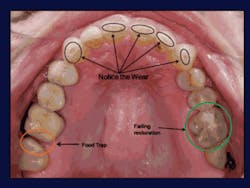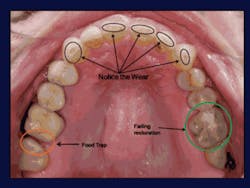How Digital co-diagnosis can change your practice
by Glenn D. Kreiger, DDS, FAGD
No matter the concentration and mission of your practice, integrating high-quality dental photography is sure to enhance your communication skills and make your practice STAND OUT.
Open any dental journal and you are sure to read about a myriad of technological advances, each promising to help patients become healthier, while at the same time offering a new financial stream for the practitioner. Almost all of the products mentioned are win-win endeavors, but in many cases acquisition costs can seem daunting.
What if I told you that you could make a modest investment in a proven piece of technology that would allow you to practice better, more comprehensive care while decreasing the pace of your practice, all with a better bottom line? Best of all, it would cost next to nothing after your initial costs.
What’s this amazing invention, you ask? It’s none other than a properly outfitted digital SLR camera. Sure, you need a little bit of training and some simple accessories, but once you get started with high-quality digital clinical photography, you’ll wonder how you ever practiced without it. We’re not talking about “wand” type cameras, which have their place in dentistry. If it’s high-level care you want to provide - the type that will help you stand out in your community - you need image quality that will wow patients and peers alike.
Virtually every dentist I have met while giving clinical photography sessions has asked me why I believe that capturing clinical images is an irreplaceable step in treatment planning. These very same dentists, after using my techniques for several months, drop me a note answering their own questions. They find images are the best way to diagnose and present treatment needs. One of my trusted mentors, when presenting to groups about comprehensive treatment planning, says, “Photography is the language of dentistry.” Amen, brother.
For years we have shown patients study casts or drawings on bracket table covers with the hope they will better understand their pathology and proposed treatment options. It’s like we have to “sell” them on the idea of what’s wrong as they try to form a mental picture of our explanations. Many patients simply never understand what we’re trying to convey. Are the patients who merely trust us and tell us to do what is best truly informed? Have we accurately fulfilled our responsibility of informed consent? How many patients leave their appointments without scheduling further treatment, and the assistant has to be revived after hearing an explanation of the problem for the umpteenth time? It’s not what we’re explaining that’s the problem, but, rather, the medium we’re using to explain.
It sounds like such a simple solution, but imagine the following scenario: A new patient goes through a thorough diagnostic process in your office. After seeing images of his or her teeth and soft tissue on a high-resolution monitor, the two of you discuss any issues that could stand in the way of optimal oral health while using the images as a reference. You and the patient discuss the pathology and numerous treatment options, and for the first time, the patient truly understands his or her dental situation and options. The patient seems eager to fix the problems, and although he or she may not go through treatment right away, when he or she does, the patient becomes your “partner” through the progression of care.
Believe it or not, this sequence of events isn’t the exception, but the rule in practices that take high-quality images. Sure, one needs to be properly introduced to the world of digital images; however, most clinicians can offer what I call “digital co-diagnosis” with just a couple of days of hands-on experience with the clinical and interpersonal components.
Clinical photography is nothing new. For many years, dentists have documented and presented cases using 35 mm slides or film. While many clinicians have success with these systems, more dentists are turned off by the inherent limitations of nondigital technology. A doctor wouldn’t know what the images looked like until the lab developed them, which could sometimes take weeks. By that time, a poorly framed or malexposed image might not be recaptured because of the hassle of photographing the patient again or the commencement of treatment. One also had to use projectors, slide viewers, or high-cost labs to enlarge images for proper patient presentations. In retrospect, it’s amazing any of us succeeded in that paradigm.
Digital photography eliminates many of the problems that make film such a hassle for dentists. The ability to instantly view or immediately retake an image is just one of the major issues that makes digital photography easier. During the learning phase, instant feedback allows clinicians to quickly become highly skilled. Last, but certainly not least, is the ability for digital images to instantly be copied, resized, printed, e-mailed, or distributed with the click of a mouse.
Another key component to digital photography is the presence of a histogram on the back of the camera after every image. Without getting into too much detail, a histogram is a diagrammatic representation of how light entering the camera is processed by tone. This diagram immediately shows the photographer whether the image was properly exposed. If not, the exposure can be adjusted and another image can be taken. It really is that simple.
If you are a person who still uses a VCR to tape shows and the clock is always blinking 12:00, do not despair. No matter what your level of experience with cameras or digital technology, nearly anyone can learn how to implement this process in the clinical setting. In as few as two days, I have taught virtually every type of dentist how to capture and seamlessly present world-class images. It truly is amazing to watch someone who doesn’t use computers in a clinical setting master the art of digital co-diagnosis. There are, however, several key concepts to keep in mind to maximize the use of clinical photography.
Learn exceptional photography
I know this sounds obvious. The problem is, many dentists believe that because we can crop, rotate, and sharpen images using software, we don’t need to capture perfect images. Nothing could be further from the truth. As dogmatic as it may sound, nothing can replace a well-composed, well-focused image. There are specific tricks that can help make that impossible maxillary arch or lateral view much easier. On more than one occasion, while teaching some of these concepts, I have seen faces light up in the classic “aha!” response. Lots of small changes will add up to a huge difference in your photographic skills.
Once you have learned to capture images that need minimal adjustments, importing them into a patient “show” is a breeze. Great images make any subsequent software uses that much easier. Photography takes time to master, while software applications, once clearly demonstrated, are easily understood. In other words, when learning this technology, the focus should be on the photography, not the software.
It’s about the process
Many dentists believe that dental photography is a means to an end. Perhaps they see it as a way of selling more anterior esthetic cases or simply making more money. If you approach clinical photography using only those two benchmarks, you will be sorely disappointed. The process of capturing the images and the valuable patient interaction while doing so are vital parts of comprehensive treatment planning. The more time you spend with patients before presenting care, the less focused you will both be on the outcome and the greater your synergy will be once care has started.
Taking images and then going through them with the patient allows most of us to see our patient’s oral cavity differently than by performing even the most thorough exam or viewing a well-mounted set of study casts. Enjoy feeling unhurried and take the time to evaluate the images along with your patients. You’ll be amazed at the difference this makes in how you plan treatment.
Practice, practice, practice
The most common mistake I see from clinicians who have attended my classes is insufficient practice of their newfound photographic skills. Furthermore, they don’t allow enough time to adequately capture images the way they would like. These clinicians become frustrated and the camera ends up in the storage closet next to the electro-mallet.
When you learned how to prepare a crown or perform endodontic therapy, more than likely you spent a little extra time practicing these procedures before becoming proficient. Great photography is no different. Although it’s far easier to get great images than to prep a crown, many of us believe that we can just walk into an operatory after attending a course and capture a full set of images in 10 minutes or less. It just won’t happen that way at first.
Sure, after a number of cases you will probably be able to capture a complete set of 12 images in 15 minutes without an assistant, but allow yourself at least 45 minutes for your first dozen or so cases. It will pay off in the long run.
Your staff should feel proud
Once you begin taking high-quality images, you will likely see your team members reacting in a peculiar, maybe even suspicious, way. Most of them have not worked with a dentist who takes images and then reviews them on a monitor with the patient. This is OK. When they hear from patients that you explained things more thoroughly than any other dentist, your team’s attitudes will shift from curiosity to pride. The more they hear it from patients, the more they will realize that your practice is not like every other practice in town. They will begin to exude a palpable confidence in both yours and their practice. If you want your team to buy in to the concept of being the best practice in town, presenting images to patients is a good start.
When I graduated from dental school, our dean made it very clear that the content of our postgraduate education was ours to choose. Our personal interests and self-directed curriculums are what make each of our dental practices unique. Some of us focus on total wellness, while others provide only esthetic dentistry. No matter the concentration and mission of your practice, integrating high-quality dental photography is sure to enhance your communication skills and make your practice stand out.
Glenn Krieger, DDS, FAGD, is the director of the Continuum for Complete Care, which provides hands-on courses to teach dentists and staff how to use high-quality clinical photography as a diagnostic tool for comprehensive treatment planning and extraordinary practice growth. Dr. Krieger also lectures on clinical photography and “Digital Co-Diagnosis” as treatment planning tools. He practices in Seattle, Wash., with an emphasis on comprehensive treatment. For more information on his lecturing or courses, visit www.betterdentalimages.com. Dr. Krieger can be reached at [email protected]. His blog address is http://dentalphotography.blogspot.com.

